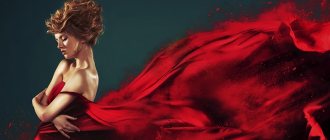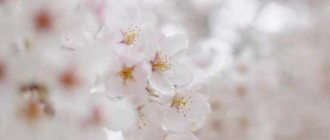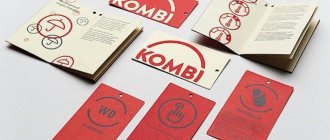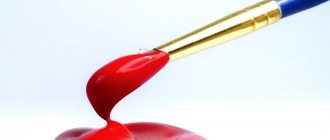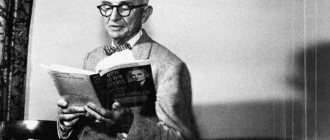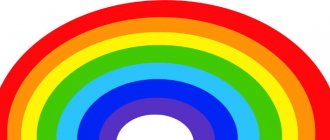The Lüscher test is a test developed by Swiss psychotherapist Max Lüscher to study personality. The essence of the test is to rank colored cards. Based on your individual preferences between colors, you can draw certain conclusions about your personality.
We invite you to take our online Self-Discovery program to get to know yourself better. In 4 weeks, with the help of psychological tests and exercises, you will find out what you really want in life and understand your strengths and weaknesses.
Content
- 1 Description of the technique
- 2 Purpose of the technique
- 3 Advantages of the technique
- 4 History of creation
- 5 Adaptations and modifications
- 6 Theoretical (methodological) foundations
- 7 Methodology structure
- 8 Procedure 8.1 Instructions (for psychologist)
- 9.1 Election markings
- 11.1 Cards
Advantages of the technique
Each of the eight colors of the test was carefully selected according to its special psychological and physiological meaning - its structure - for this purpose, preliminary experiments were carried out over the course of five years with 4500 shades of colors. Their meaning is universal, it remains the same for different countries, does not depend on age, the same for men and women, educated and uneducated, or “civilized” and “uncivilized.” Many people are prejudiced against “psychological tests” primarily if they have to answer countless, time-consuming questions or if they are forced to sort through a lot of cards. Experience with the Luscher test shows that the number of those who do not accept it is very small. The test is attractive, it can be completed quickly, and the test takers do not feel that they are compromising their dignity by choosing colors. They might change their minds if they knew how revealing the test really is.
History of creation
The first edition of the test, which brought the author worldwide fame, was published in 1948. In 1970, M. Luscher released a voluminous manual for his test. The theory and practice of the method are also presented in such books by Luscher as “Personality Signals”, “The Four-Color Man”, etc.
The test colors were selected experimentally by Luscher from 4,500 color tones. The author specifically emphasizes that adequate diagnostics from the standpoint of his method is only possible when using a standard, patent-protected set of color stimuli.
Adaptations and Modifications
The color selection method proposed by L.N. Sobchik is an adapted version of the Luscher color test. The method is intended to study unconscious, deep-seated problems of personality, current state, basic needs, individual style of experience, type of response and degree of adaptation of the subject. In addition, it allows us to identify a person’s compensatory capabilities and assess the severity of painfully acute character traits and clinical manifestations.
What is the Luscher test used for?
The Luscher test is one of the most popular in psychology. It is widely used by psychologists to create an emotional portrait of a patient.
Potential employers test candidates using the Luscher method in order to understand their readiness for work and identify their predisposition to a particular field of activity.
Marketing research using this methodology plays an important role. Based on the color preferences of the target audience, marketers develop labels, banners and other promotional products.
Theoretical (methodological) foundations
The development of the Luscher test is based on a purely empirical approach and is initially associated with the aim of studying the emotional and physiological state of a person for the purpose of a differentiated psychotherapeutic approach and to assess the effectiveness of corrective action. The technique is devoid of any serious theoretical justification, hints of which appeared only in the later works of both Luscher himself and his followers. The interpretative approach of the methodology, which is very eclectic, is based on the socio-historical symbolism of flowers, elements of psychoanalysis and psychosomatics. The experience of using the Luscher eight-color test in domestic conditions not only confirmed its effectiveness, but also made it possible to comprehend its phenomenology in the context of the modern scientific worldview. Its advantage over many other personality tests is that it is devoid of cultural and ethnic basis and does not provoke (unlike most other, especially verbal tests) reactions of a defensive nature. The technique reveals not only the conscious, subjective attitude of the subject to color standards, but mainly his unconscious reactions, which allows us to consider the method as deep, projective.
Method structure
The Luscher test in the original is presented in two versions: a full study using 73 color tables and a short test using an eight-color series. The first of them is quite cumbersome and is most likely of value in cases where the color test is the only tool for psychodiagnostic research. At the same time, the final result of the research is not so extensive information compared to the time and effort spent. The brevity and ease of use of the eight-color range is a great advantage of the shortened version, especially since when applied to a battery of test methods, the reliability of the data obtained increases. Full version of the Luscher test
The full version of the CTL - “Clinical Color Test” consists of 7 color tables:
- "gray"
- "8 colors"
- "4 primary colors"
- "of blue color"
- "Green colour"
- "Red"
- "yellow color"
To table 1
“gray color” includes - medium gray (0; it is similar to gray from the 8-color table), dark gray (1), black (2; similar to 7 from the 8-color table), light gray (3) and white (4).
table 2
The full version is similar to the 8-color table of the short version of the Luscher test.
Table 3:
dark blue (I1), blue-green (D2), red-yellow (O3) and yellow-red (P4). Each color is presented in the table 3 times (as well as the colors of subsequent tables) for the purpose of pairwise comparison of colors by the subjects. The colors are similar to the 4 “primary” tones in Table 2.
Table 4:
dark blue (I1), green-blue (D2), blue-red (O3), light blue (P4). In this table, the dark blue color (I1) is similar to the dark blue in tables 2 and 3. The use of the same color (“main”) in several CTL tables allows, from Luscher’s point of view, to more deeply study the subject’s attitude towards it .
Table 5:
brown-green (I1), blue-green (D2), green (O3) and yellow-green (P4). Here, for the third time, blue-green (D2) is present.
Table 6:
brown (I1), red-brown (D2), red-yellow (O3), orange (P4). The first of these colors is similar to 6 from Table 2, and red-yellow (O3) appears the 3rd time.
Table 7:
light brown (I1), green-yellow (D2), orange with a greater proportion of red (O3) and yellow-red (P4). In the last CTL table, the yellow-red color (P4) is repeated for the third time.
CTL colors, starting in Table 4, refer to specific “color columns.” There are four of them - according to the number of “primary” colors. The “blue” column (I1) includes colors designated I1, the “green” (D2) column contains D2; “red” (O3) - O3; “yellow” (P4) - P4. Short version of the Luscher test
The short version is a table of eight colors:
- gray (conditional number - 0)
- dark blue (1)
- blue-green (2)
- red-yellow (3)
- yellow-red (4)
- red-blue or purple (5)
- brown (6)
- black (7)
Brown (6)
Brown is a darkened yellow-red. The impulsive vitality of red in brown is darkened, muted, calmed or "broken" as the artist would say. Brown has an expansive impulse that lacks the active vitality of red. Liveliness no longer acts actively, but is perceived passively. The color brown represents vibrant sensory perception. Therefore, the position of the brown color gives an idea of the relationship to life's physical sensations. If the brown color is in the position of indifference, in the fifth, sixth or seventh place, then the vital perception of the body is “destroyed”, since a healthy and satisfied body is not felt. But if he stands in the first half of the row or even in the first two places, then there is an increased need for rest, created by comfort and sensual peace. Brown color is preferred when it corresponds to problem-free, conflict-free comfort.
If brown is in eighth place, then its stress-free comfort is rejected. The color brown is perceived as a dull banality of a “man from the crowd”, from which the chooser, as an individualist, would like to be different. Because of this, the ability to receive sensual pleasure suffers, resulting in a deficit that causes compensation, including obsessive sexual ideas.
Brown color attracts attention if it is not in places five to seven.
Procedure
The examination procedure proceeds as follows: the subject is asked to choose the most pleasant color from the tables laid out in front of him, without correlating it with the color of the clothes (does it suit the face), or with the upholstery of the furniture, or with anything else, but only in accordance with the fact that how much we prefer this color in comparison with others for a given choice and at the moment.
When laying out color standards in front of the subject, you should use an indifferent background. The lighting should be uniform and bright enough (it is better to conduct the study in daylight). The distance between color tables must be at least 2 cm. The selected standard is removed from the table or turned face down. In this case, the psychologist writes down the number of each selected color standard. The recording goes from left to right. The numbers assigned to the color standards are as follows: dark blue - 1, blue-green - 2, orange-red - 3, yellow - 4, purple - 5, brown - 6, black - 7, gray - 0.
Each time the subject should be asked to choose the most pleasant color from the remaining ones until all colors have been selected. After two to five minutes, having first mixed them in a different order, the color tables must be laid out again in front of the subject and the selection procedure must be completely repeated, saying that the study is not aimed at studying memory and that he is free to choose again the colors he likes the way he likes. it will be whatever.
Instructions (for a psychologist)
Shuffle the colored cards and place them with the colored surface facing up. Ask the subject to choose from eight colors the one he likes best. In this case, it must be explained that he must choose the color as such, without trying to correlate it with his favorite color in clothes, eye color, etc. The test subject must select the most pleasant Color out of eight. The card with the selected color should be set aside, turning the colored side down. Ask to choose the most pleasant one from the remaining seven colors. The selected card should be placed with the colored side down to the right of the first one. Repeat the procedure. Rewrite the card numbers in laid out order. After 2-3 minutes, place the cards again with the color side up and do the same. At the same time, explain that the subject should not remember the order of the layout in the first choice and consciously change the previous order. He should choose colors as if for the first time.
Black (7)
Black is the darkest color. In black the concentric direction of dark colors is completed until the final point. Black is the absolute border where life ends. Therefore, the color black expresses the idea of “nothing.” Black is negation in relation to affirmation, which reaches its highest point in white as absolute freedom (hence impeccability). The banners of the anarchists and nihilistic unions were black. Black color conveys accumulation, defense and repression of the effects of irritants. Therefore, black means refusal. Anyone who chooses black as the color first wants to refuse out of wayward protest. He rebels against his fate. He who chooses the color black in second place believes that he can give up everything if he can force what the color expresses in first place before black. If, for example, red comes first before black, then unbridled experiences should compensate for deprivation. If blue is in front of black, then peace without tension should recreate the destroyed harmony. If there is a gray person in front of black, then complete fencing should help overcome the unbearable condition. Anyone who chooses black in eighth place, where it is found most often according to statistics, does not want to give up. For him, refusal means deprivation and frightening scarcity. Since he cannot refuse, he avoids danger and makes increased demands that are authoritarian in nature.
Processing the results
The first choice in the Luscher test characterizes the desired state, the second - the actual one. Depending on the purpose of the study, the results of the relevant testing can be interpreted.
As a result of testing, we get eight positions:
- the first and second are a clear preference (denoted by + +);
- third and fourth - preference (denoted x x);
- fifth and sixth - indifference to color (denoted = =);
- seventh and eighth - antipathy to color (indicated - -)
Based on an analysis of more than 36,000 research results, M. Luscher gave an approximate description of the selected positions:
- 1st position - the color you like the most, indicates the main method of action, i.e. a means to achieve the goals facing the subject.
- 2nd position - usually the color in this position is also indicated by a “+” sign, and in this case it means the goal that the subject is striving for.
- 3rd and 4th positions - usually the colors in these positions are indicated by the sign "x" and indicate the true state of affairs, situation or course of action arising from this situation (for example, the blue color in this case will mean - the subject feels that he is in a calm environment or that the situation demands that he act calmly).
- 5th and 6th positions - colors located in these positions and indicated by the “=” sign indicate specific features that do not cause hostility, are not associated with the existing state of affairs, currently unused reserves, personality traits.
- 7th and 8th positions - the color in these positions, marked with a “-” sign, means the existence of a suppressed need or a need that should be suppressed because its implementation would lead to unfavorable results.
Election markings
When reselecting colors, if two or more colors change position, but still remain near the color that was their neighbor in the first choice, then the group exists, and it is this group of colors that should be circled and marked with the sign corresponding to the function. Very often these groups differ somewhat from simple grouping into pairs.
Example:
1st choice - 31542607
2nd choice - 35142670
Grouping is done as follows:
| 3 | 1 | 5 | 4 | 2 | 6 | 0 | 7 |
| 3 | (5 1) | (4 2 6) | (7 0) | ||||
| + | X | X | = | = | = | — | — |
When making notes in the protocol of such a test, you should be guided by the following rules:
- The first group (or one digit) is marked “+”.
- The second group (or one digit) is marked with an "x".
- The last group (or one digit) is marked “-”.
- All other colors are marked with a “=” sign.
Where there are pairs of colors, interpretation should be made using these rather than individual colours.
Sometimes the same colors will have different symbols on the 1st and 2nd choices. In this case, each choice should be marked separately:
| + | + | X | = | = | — | — | — |
| 5 | 1 | 3 | 4 | 2 | 6 | 0 | 7 |
| 3 | 5 | 1 | 4 | 2 | 7 | 6 | 0 |
| + | X | X | = | = | = | — | — |
Usually the second choice is more spontaneous and therefore more valid than the first, especially in cases of doubt. In this regard, when using tables, you should first take into account the grouping and notes made during the second choice.
It may turn out that some numbers are common to two functional groups and then both groups should be interpreted with the corresponding notes in the protocol:
| + | + | — | — | |||||
| + | X | X | = | = | = | = | — | |
| 5 | 1 | 3 | 4 | 0 | 6 | 2 | 7 | 1st choice |
| 3 | 1 | 5 | 4 | 0 | 7 | 2 | 6 | 2nd choice |
| + | + | X | = | = | = | = | — |
In this case, you need to look at the following groups in the tables: +3+1, x1×5, =4=0, -2-6 (there are also additional groups: +3-6 and +3-2).
Basic Rules
When taking the test, the subject must follow the rules so that the results obtained are as close as possible to his real experiences. The subject has the right:
- ask clarifying questions before starting the procedure;
- receive paper instructions that remain on the table while taking the test;
- refuse to undergo it if the technique causes him discomfort.
The subject is obliged:
- carefully follow the order of the test procedure;
- be as clear as possible when choosing your preferred colors;
- do not change the color choice after it has already been made.
The basic rule is that the subject must be in an adequate state, otherwise conducting a technique with the need to choose does not make sense.
Interpretation of results
One of the methods for interpreting the selection results is to evaluate the position of the primary colors. If they occupy a position further than the fifth, it means that the properties and needs they characterize are not satisfied, therefore, there is anxiety and a negative state. Detailed description of the meaning of colors.
The relative position of the primary colors is considered. When, for example, No. 1 and 2 (blue and yellow) are located next to each other (forming a functional group), their common feature is emphasized - the subjective orientation “inward”. The combined position of colors No. 2 and 3 (green and red) indicates autonomy, independence in decision-making, and initiative. The combination of colors No. 3 and 4 (red and yellow) emphasizes the “outward” direction. The combination of colors No. 1 and 4 (blue and yellow) enhances the representation of the subjects’ dependence on the environment. When colors No. 1 and 3 (blue and red) are combined in one functional group, a favorable balance of dependence on the environment and subjective orientation (blue) and autonomy, “outward” orientation (red) is emphasized. The combination of green and yellow colors (No. 2 and 4) is considered as a contrast between the subjective desire “inward”, autonomy, stubbornness and the desire “outward”, dependence on the environment.
Primary colors, according to Max Luscher, symbolize the following psychological needs:
- No. 1 (blue) - the need for satisfaction, peace of mind, stable positive attachment;
- No. 2 (green) - the need for self-affirmation;
- No. 3 (red) - the need to actively act and achieve success;
- No. 4 (yellow) - the need for perspective, hopes for the best, dreams.
If the primary colors are in positions 1–5, it is believed that these needs are satisfied to a certain extent and are perceived as being satisfied; if they are in the 6th - 8th positions, there is some kind of conflict, anxiety, dissatisfaction due to unfavorable circumstances. A rejected color can be seen as a source of stress. For example, the rejected blue color means dissatisfaction with the lack of peace and affection.
Max Lüscher took into account the possibilities of assessing performance during the analysis of color choice based on the following premises.
- Green color characterizes the flexibility of volitional manifestations in difficult operating conditions, which ensures the maintenance of performance.
- Red color characterizes willpower and a feeling of satisfaction with the desire to achieve a goal, which also helps maintain performance.
- Yellow color protects hopes for success, spontaneous satisfaction from participation in an activity (sometimes without a clear understanding of its details), and orientation towards further work.
If all these three colors are at the beginning of the row and all together, then more productive activity and higher performance are likely. If they are in the second half of the row and separated from each other, the prognosis is less favorable.
Anxiety indicators. If the main color is in 6th place, it is indicated by the sign -, and all the others that are behind it (7th - 8th positions) are indicated by the same sign. They should be considered as rejected colors, as a cause of anxiety and a negative state.
In the Luscher test, such cases are additionally marked with the letter A above the color number and a sign - for example: Compensation indicators. If there is a source of stress or anxiety (expressed by any primary color placed in the 6th and 8th positions), the color placed in the 1st position is considered as an indicator of compensation (compensating motive, mood, behavior). In this case, the letter C is placed above the number occupying 1st place. It is considered a more or less normal phenomenon when compensation occurs due to one of the primary colors. At the same time, the very fact of the presence of an indicator of stress and compensation always indicates a suboptimal state. In those cases where compensation occurs through additional colors, the test results are interpreted as indicators of a negative state, negative motives, and a negative attitude towards the surrounding situation.
| ! | !! | !!! |
| A | A | A |
| 2 | 1 | 4 |
Indicators of anxiety intensity are characterized by the position occupied by the primary colors. If the primary color is in 6th place, the factor causing anxiety is considered relatively weak (this is indicated by one exclamation point); if the color is in the 7- and position, two exclamation marks are placed (!!); if the main color is in the 8th position, three signs (!!!) are placed. In this way, up to 6 signs can be placed characterizing sources of stress and anxiety, for example:
Similarly, the Lüscher test evaluates cases of adverse compensation. If the compensation is any of the primary colors or purple, no marks are placed. If gray, brown or black occupy the 3rd position, one exclamation mark is placed; if the 2nd position, two marks (!!), if the first position, three marks (!!!). So there can be 6 of them, for example:
| !!! | !! | ! |
| WITH | WITH | WITH |
| + | + | + |
| 6 | 0 | 7 |
It is believed that the more “!” signs, the more unfavorable the prognosis. Taking into account the test results obtained, it is advisable to organize activities for the regulation and self-regulation of mental states and autogenic training. Repeated testing after such events (in combination with other methods) can provide information about reducing anxiety and tension.
Of particular importance when interpreting test results is the assessment of the color in the last 8th position (or in the 4th functional group if there are two colors with a “—” sign). If the colors in this position are marked with exclamation marks, then the likelihood of the subject developing a state of anxiety is quite high.
Pay attention to the ratio of the first and eighth positions, is there compensation, is it built according to a normal scheme?
The relationship of colors in the second and third positions (desired goal and actual situation) can also be analyzed. Is there any conflict between them? For example, red in the second and gray in the third position symbolize the conflict between goals, motives and self-esteem of one’s actual state. When analyzing and interpreting the results of the Luscher test, the obtained psychodiagnostic information should be compared with materials from questionnaires, observations, conversations, and study of documents about the subjects. Only with such a comprehensive study of personality can one make any serious conclusions about personality traits and its psychological characteristics.
The same should be said about the prospects for using test results to assess state, in particular emotional state, tension, and anxiety. However, the coincidence of the indicators of the color test (choice of colors No. 6, 7, 0 in the first position) and the data from the questionnaire and observation allows us to judge with greater confidence the development of various negative states in the subjects.
Purple color (5)
Purple color is a mixture of red and blue. The color violet tries to create a single fusion of opposites, that is, from red, like an impulsive conqueror, and blue, like gentle selflessness; and therefore it is an expression of identification. Such identification is a delicate feeling that becomes the only possible emotion, so that everything I think and want must correspond to reality. This power is called magic, magic, and this is precisely the meaning of purple. Anyone who prefers the color purple would like a magical relationship. He wants to be bewitched, but he himself would like to have witchcraft power and impressive charm, since in magical identification the opposition between subject and object is destroyed. Purple color - this can be identified as an erotic fusion, or as an intuitive-sensual understanding. But it can simply mean unity, as well as undifferentiation and unresolvedness. Thus, testing of 1,600 schoolchildren who had not reached puberty showed that 75% preferred the color purple. Test statistics from 1,000 Iranians, blacks from Tangonica and Gao, and Indians from central Brazil reveal a marked preference for the color purple. The action of hormones also apparently leads to a preference for violet, as shown by studies carried out among women during pregnancy (Erbele), as shown by tests for functional disorders of the thyroid gland, and as shown by experiments with the choice of colors in homosexuals.
If the color purple is chosen in eighth place, then the desire for a sensual erotic fusion, the magic of identification with one’s partner, is hidden in secret because there are no prerequisites. This gives rise to an often undetected isolation and the desire to create the clearest possible relationships. The ability for emotional premonition and the need for the magic of enchantment are transferred to such objects that require aesthetic evaluation and embodiment and which often become a professional task.
Violet does not attract attention when it is in places three through seven, even if it is in second place during pregnancy or before puberty.




